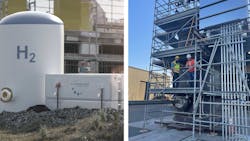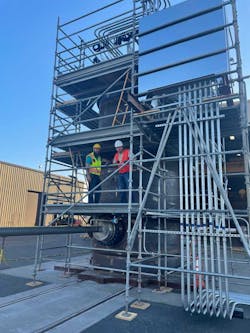Zero-Emission Heater Lets Reformer Cleanly Turn Methane into Hydrogen
READ MORE: Basics of Ceramic Heaters
Engineers at Raven SR Inc., Pinedale, Wyo., have developed the SR2, a non-combustion equilibrium steam/CO2 reformer that converts methane to transportation-grade hydrogen. In tests, the prototype outperformed the other commercially available technologies for making hydrogen from methane.
“Typical conversion rates for steam methane reformers are 60%,” says Matt Murdock, CEO of Raven SR. “The SR2’s conversion rate is significantly higher. And because our reformer is electrical and there’s no need to burn or otherwise oxidize fuel to supply the necessary energy, it does not create the NOx/SOx emissions typical of SMRs. The reformer does create extremely low levels of emissions, but they are well-below CARB standards.”
The SR2 reformer uses no combustion because it relies on electro-thermal heaters and controls from Watlow. “Raven opted for them because they can provide the power levels needed and can managing several heaters simultaneously, according to their spokesperson,” says Mike Fatigati, chief technology officer at Raven.
The heaters and controls provide a wide range of temperature control. High-temperature Multicell heaters let operators or software adjust the temperature profiles for the different zones inside the reformer.
READ MORE: How to Determine the Temperature Class of an Electrical Process Heater
The control panels, which use Watlow temperature and power controllers, monitor all thermal/electrical characteristics to ensure proper conditions inside the reformer. Watlow engineers also developed a special IoT device that lets operators log data and monitor near real-time outputs of the heaters’ thermal performance. “The IIoT approach also provides a foundation for diagnostic and predictive analytics of the system,” says Trevor Smith, staff engineer at Watlow.
The SR2’s dioxide reforming process transforms all waste—including biomass, municipal solid waste, bio-solids, industrial waste, sewage and medical waste, as well as unwanted, unusable, excess, low-methane natural gas—into synthetic gas or a biocarbon, depending on the feedstock being transformed.
“The synthetic gas can be converted into renewable energy products including hydrogen, sulfur, and nitrogen-free Fischer-Tropsch synthetic fuels, additives and solvents. The biocarbon can be sold for fertilizer or to improve the soils, as well as for asphalt or concrete filler,” notes Fatigati.
Raven SR’s first commercial steam/CO2 reforming facility is scheduled to come online early next year at the West Contra Costa sanity landfill in Richmond, Calif. It will convert organic green waste into transportation-grade hydrogen for local customers.

